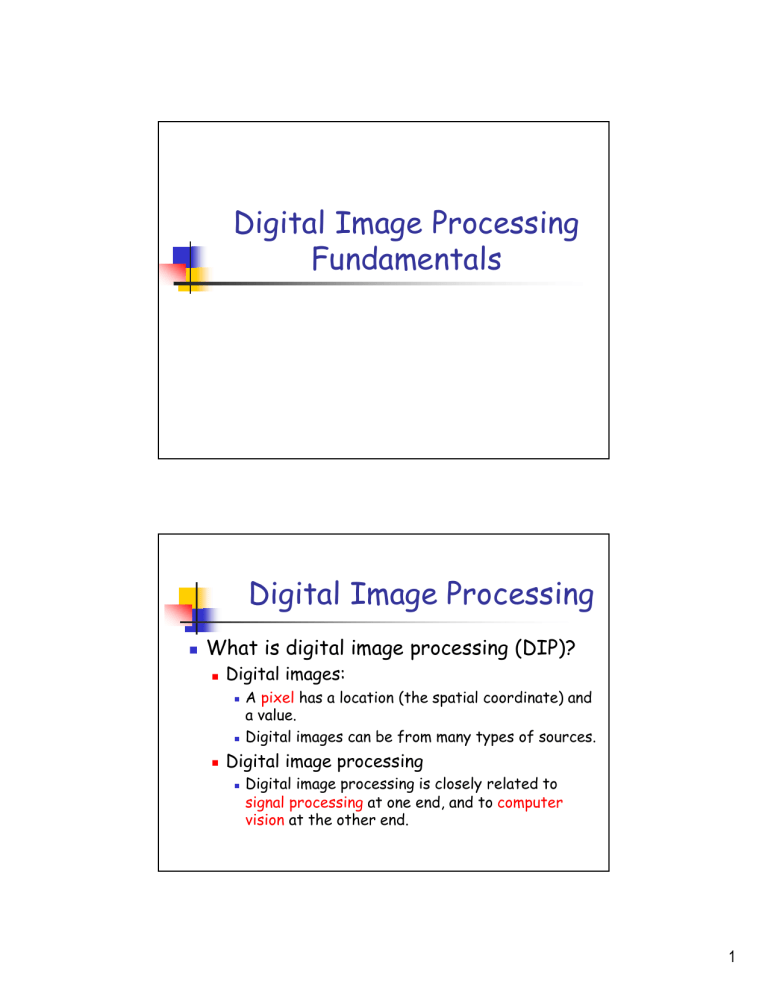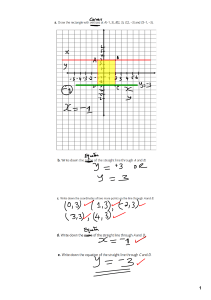
Digital Image Processing Fundamentals Digital Image Processing What is digital image processing (DIP)? Digital images: A pixel has a location (the spatial coordinate) and a value. Digital images can be from many types of sources. Digital image processing Digital image processing is closely related to signal processing at one end, and to computer vision at the other end. 1 Computer Vision Computer vision: Computer vision is concerned with making computers “understand” what is contained in an image and other functions of human vision. It is sometimes considered to be a topic of artificial intelligence. However, it is not possible to state exactly where image processing ends and computer vision begins. If you compare a digital image processing book and a computer vision book, you will find a lot of overlap. Human and Computer Vision We can’t think of image processing without considering the human vision system. We observe and evaluate the images that we process with our visual system. Without taking this elementary fact into consideration, we may be much misled in the interpretation of images. 4 2 Simple questions What intensity differences can we distinguish? What is the spatial resolution of our eye? How accurately we estimate and compare distances and areas? How do we sense colors? By which features can we detect and distinguish objects? 5 Human Eye 6 3 Structure of the Human Eye Shape is nearly a sphere. Average diameter = 20 mm. 3 membranes: Cornea and Sclera – outer cover Choroid Retina -enclose the eye 7 Structure of the Human Eye Cornea : tough, transparent tissue, covers the anterior surface of the eye. Sclera : Opaque membrane, encloses the remainder of the optic globe Choroid : Lies below the sclera, contains network of blood vessels that serve as the major source of nutrition to the eye. 8 4 Structure of the Human Eye Lens both infrared and ultraviolet light are absorbed appreciably by proteins within the lens structure and, in excessive amounts, can cause damage to the eye. Retina Innermost membrane of the eye which lines inside of the wall’s entire posterior portion. When the eye is properly focused, light from an object outside the eye is imaged on the retina. 9 Receptors Pattern vision is afforded by the distribution of discrete light receptors over the surface of the retina. Receptors are divided into 2 classes: Cones: 6-7 million, located primarily in the central portion of the retina, highly sensitive to color, and each is connected to its own nerve end Rods : 75-150 million, distributed over the retina surface, several rods are connected to a single nerve, and sensitive to low levels of illumination 10 5 Test images 11 Test images Test images for distances and area estimation: a) Parallel lines with up to 5% difference in length. b) Circles with up to 10% difference in radius. c) The vertical line appears longer but actually has the same length as the horizontal line. d) Deception by perspective: the upper line appears longer than the lower one but actually have the same length. 12 6 Test images 13 Test images 14 7 Signals A signal is a function that carries information. usually content of the signal changes over some set of spatiotemporal dimensions. Signals vary over time: f(t) for example: audio signal may be f(t) thought at one level as a collection various tones of differing audible frequencies that vary over time. 15 Spatially-Varying Signals Signals can vary over space as well. An image can be thought of as being a function of 2 spatial dimensions: f(x,y) for monochromatic images, the value of the function is the amount of light at that point. medical CAT and MRI scanners produce images that are functions of 3 spatial dimensions: f(x,y,z) 16 8 Spatiotemporal Signals What do you think a signal of this form is? f(x,y,t) x and y are spatial dimensions; t is time. Perhaps, it is a video signal, animation, or other time-varying picture sequence. 17 Types of Signals Most naturally-occurring signals are functions having a continuous domain. however, signals in a computer have are discrete samples of the continuous domain. In other words, signals manipulated by computer have discrete domains. 18 9 Analog & Digital Most naturally-occurring signals also have a real-valued range in which values occur with infinite precision. to store and manipulate signals by computer we need to store these numbers with finite precision. thus, these signals have a discrete range. signal has continuous domain and range = analog signal has discrete domain and range = digital 19 Sampling & Quantization Sampling = the spacing of discrete values in the domain of a signal. sampling-rate = how many samples are taken per unit of each dimension. e.g., samples per second, frames per second, etc. f(t) Quantization = spacing of discrete values in the range of a signal. usually thought of as the number of bits per sample of the signal. e.g., 1 bit per pixel (b/w images), 16bit audio, 24-bit color images, etc. 20 10 Image Representation A digital image is an image f(x,y) that has been digitized both in spatial coordinates and brightness. the value of f at any point (x,y) is proportional to the brightness (or gray level) of the image at that point. 21 Image Representation 22 11 Image Representation A digital image can be considered a matrix whose row and column indices identify a point in the image and the corresponding matrix element value identifies the gray level at that point. 23 Image Representation 24 12 Sampling and Quantization 25 Light-intensity function image refers to a 2D light-intensity function, f(x,y) the amplitude of f at spatial coordinates (x,y) gives the intensity (brightness) of the image at that point. light is a form of energy thus f(x,y) must be nonzero and finite. 0< f(x,y)<∞ 26 13 Illumination and Reflectance the basic nature of f(x,y) may be characterized by 2 components: the amount of source light incident on the scene being viewed Illumination, i(x,y) the amount of light reflected by the objects in the scene Reflectance, r(x,y) 27 Illumination and Reflectance determined by the nature of the light source determined by the nature of the objects in a scene bounded from total absorption to total reflectance. 28 14 Gray level 29 Number of bits 30 15 Resolution 31 Checkerboard effect 32 16 False contouring 33 Relationship between pixels Neighbors of a pixel Connectivity Distance Measures Arithmetic/Logic Operations 34 17 Neighbors of a pixel 35 Connectivity Let V be the set of gray-level values used to defined connectivity 4-connectivity : 2 pixels p and q with values from V are 4connected if q is in the set N4 (p) 8-connectivity :2 pixels p and q with values from V are 8connected if q is in the set N8 (p) m-connectivity (mixed connectivity): 2 pixels p and q with values from V are m-connected if q is in the set N4 (p) or q is in the set ND (p) and the set N4(p)∩N4 (q) is empty. (the set of pixels that are 4-neighbors of both p and q whose values are from V ) 36 18 Example m-connectivity eliminates the multiple path connections that arise in 8connectivity. 37 Adjacent a pixel p is adjacent to a pixel q if they are connected. two image area subsets S1 and S2 are adjacent if some pixel in S1 is adjacent to some pixel S2. 38 19 Path a path from pixel p with coordinates (x,y) to pixel q with coordinates (s,t) is a sequence of distinct pixels with coordinates (x0,y0),(x1,y1),…(xn,yn) where (x0,y0) = (x,y) , (xn,yn) = (s,t) and (xi,yi) is adjacent to (xi-1,yi-1) n is the length of the path we can define 4-,8-, or m-paths depending on type of adjacency specified. 39 Exercise e 40 20 Distance Measures 41 Euclidean distance 42 21 City-block distance: D4 distance 43 Chessboard distance: D8 distance , 44 22 D4 and D8 distances 45 m-connectivity’s distance 46 23 Arithmetic Operators 47 Logic operations 48 24 Mask Operation 49 Mask Operation 50 25 Mask operator 51 Mask coefficient Proper selection of the coefficients and application of the mask at each pixel position in an image makes possible a variety of useful image operations noise reduction region thinning edge detection Applying a mask at each pixel location in an image is a computationally expensive task. 52 26 Image Geometry Basic Transformations : expressed in 3D Cartesian coordinate system (x,y,z) Translation Scaling Rotation Concatenation and inverse transformation 53 Translation . 54 27 Geometry General Form V* = AV A : 4x4 transformation matrix V : column vector containing the original coordinates V* : column vector whose components are the transformed coordinates 55 Translation matrix 56 28 Scaling 57 Rotation 58 29 Rotation 59 Rotation 60 30 Concatenation and inverse transformation 61 31

